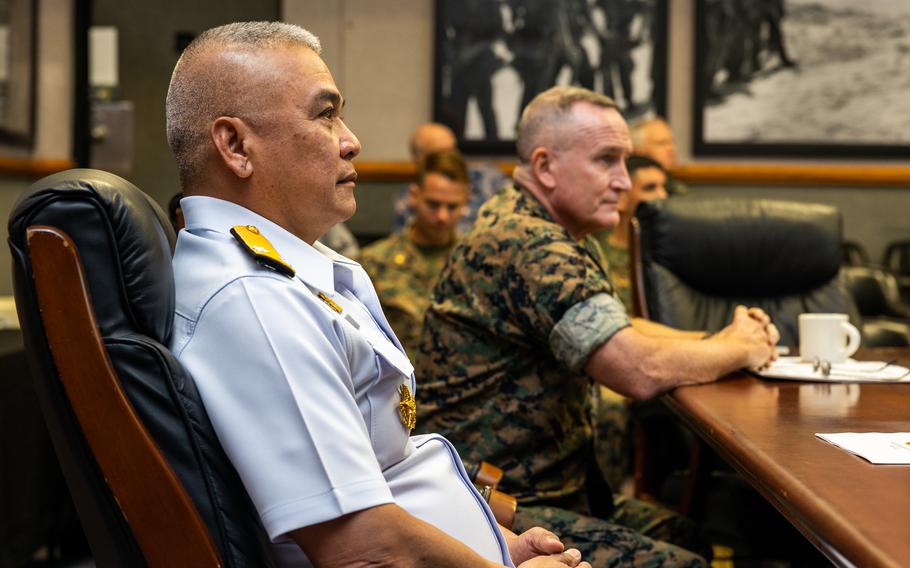
Rear Adm. Utai Youngwilai, left, chief of staff, Royal Thai Marine Corps, and U.S. Marine Corps Lt. Gen. William M. Jurney, commander, U.S. Marine Corps Forces Pacific, participate in the first Marine-to-Marine Future Engagement Planning event at Camp H. M. Smith, Hawaii, May 8, 2023. (Blake Gonter/U.S. Marine Corps)
(Tribune News Service) — U.S. Marine Corps Forces Pacific hosted a delegation from the Royal Thai Marine Corps on Oahu on Monday and Tuesday for the first Marine-to-Marine Future Engagement Planning meetings between the United States and Thailand.
The meeting took place as the United States and China compete for influence in Southeast Asia, and as the Marine Corps seeks to assert itself as a major player in U.S. strategy in the region. In a news release, the Marines' top officer in the Pacific, Lt. Gen. William Jurney, said "our goal is more than just training and doing things together; we must be ready to respond to a variety of contingencies."
Thailand is the United States' oldest treaty ally in Asia and this year marks the 190th anniversary of diplomatic ties between the two countries.
In March, militaries from both countries teamed up for the 42nd annual Cobra Gold military exercise in Thailand — the largest iteration of the exercise in recent years.
Concerns about COVID-19 led to significantly scaled back exercises. In 2022, the United States sent less than 1,300 troops to Cobra Gold, which drew a total of less than 3,500 participants. This year it included more than 7,000 service members from 30 countries, including the United States, Indonesia, Singapore, Japan, Malaysia, South Korea, India and Australia. A small detachment of Chinese troops also joined the exercise for the humanitarian aid portion.
The Marine Corps is stepping up meetings with regional countries in the Pacific and Asia as it seeks to reorganize its forces and refocus its priorities after years of drawn-out counterinsurgency battles in the Middle East. Service brass envision Marines returning to their naval roots conducting the sorts of "island hopping" missions they did during World War II, but with a 21st-century twist.
Service leaders picture relatively small groups of Marines operating spread out across islands and the ocean and setting up missile batteries to sink enemy ships, while using drones and other technologies to support their operations. They also say they hope that a more agile and mobile Marine Corps can more quickly respond to humanitarian crises in the region as climate change and rising seas make natural disasters more common.
In pursuing the new strategy, Marine Corps leaders are looking to bolster alliances and partnerships with regional countries so that their Marines can partner with foreign troops, as well as access their bases.
The Marine Corps makeover is largely tailored for operations in the Western Pacific, where China has been embroiled in a series of disputes with neighboring countries over territorial and navigation rights in the South China Sea, a critical waterway that more than a third of all international trade moves through. Beijing considers the entire sea its exclusive territory and has built bases on disputed islands and reefs to assert its claims.
China has sought to invest heavily in Southeast Asia as part of its Belt and Road Initiative — sometimes called the "new Silk Road" — with some Chinese officials and business leaders having ambitious goals for Thailand in particular. They have been pushing hard for the construction of the Kra Canal — potentially the largest canal in southeast Asia — which would be built with Chinese money and give Chinese merchant and military vessels a shortcut to the Indian Ocean.
China, along with many other countries in Asia and the Pacific, imports oil from Africa and the Middle East that often makes its way through the Strait of Malacca. The canal would allow tankers to move straight through Thailand between the Indian and Pacific oceans.
But some analysts are concerned Beijing would use the canal to exert control over maritime movements and trade in the region. In 2018, a senior Indian navy official told Indian English-language newspaper the Business Standard that "in theory, the Kra Canal could benefit India and the region by taking pressure off the overcrowded Malacca Straits. In practice, there's reason to worry about what Chinese involvement in this project will mean for the balance of power in the Indian Ocean."
In January 2020, the Thai government formed a parliamentary committee to study the feasibility of the canal project. The committee submitted its report to the Thai House for debate last year, where lawmakers ultimately concluded it wasn't feasible. But some analysts contend Chinese officials continue to try to leverage connections with members of the Thai military establishment and business community in hopes of keeping the proposed project alive.
As COVID-19 restrictions wind down around the world, the U.S. military is stepping up face-to-face talks with its regional counterparts in hopes of strengthening their own personal ties. In the Marine Corps news release, officials said they plan for the meeting at Camp Smith to become an annual event. Jurney said "we want to work together in the bonds of friendship to strengthen our readiness."
(c)2023 The Honolulu Star-Advertiser
Visit at www.staradvertiser.com
Distributed by Tribune Content Agency, LLC.